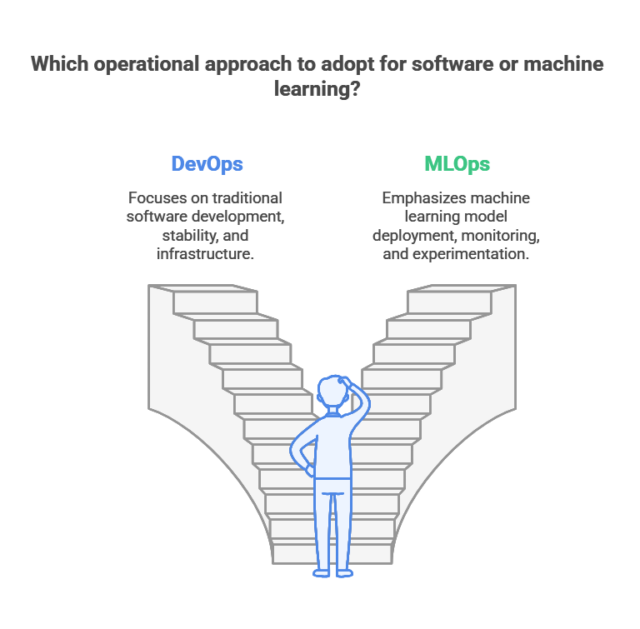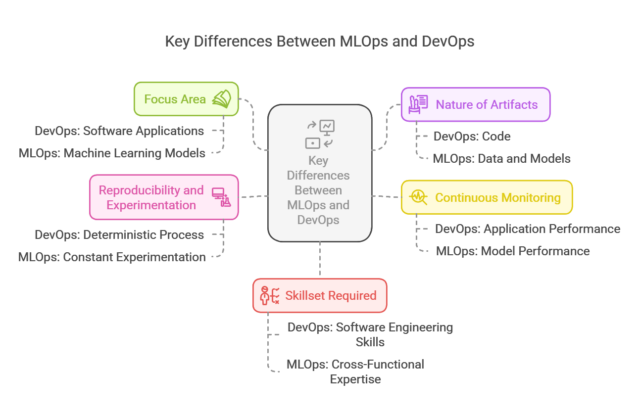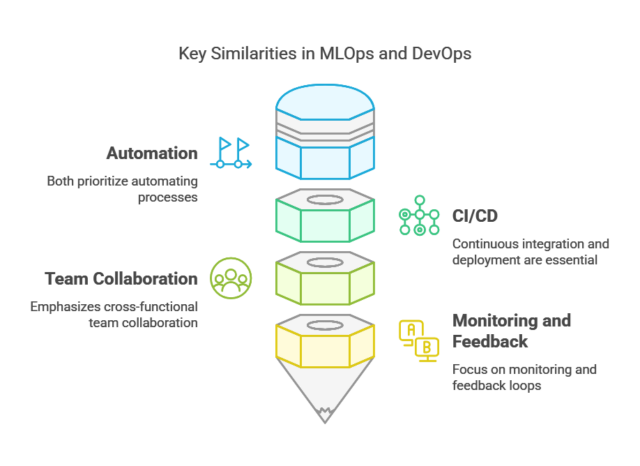Introduction:
The rapid growth of machine learning (ML) has led to the emergence of a new set of practices tailored specifically for ML workflows—MLOps. As organizations seek to integrate machine learning models into their software systems, the need for specialized tools and processes has become clear. However, this raises the question: how does MLOps differ from the established software development approach of DevOps?
In this blog, we’ll explore the key differences and similarities between MLOps and DevOps and outline the best practices that organizations should adopt for each to optimize their workflows and ensure success in deploying and managing applications.
What is DevOps?
DevOps is a set of practices and cultural philosophies that aim to shorten the software development lifecycle and provide continuous delivery with high software quality. It bridges the gap between software development and IT operations by fostering collaboration, automation, and monitoring across all stages of the development process
What is MLOps?
MLOps (Machine Learning Operations) is a set of practices that unites machine learning system development and operations to automate the lifecycle of machine learning models, from data collection to model deployment and monitoring. MLOps addresses the complexities and challenges specific to machine learning workflows, such as model versioning, model drift, data quality, and scalability.

Key Differences Between MLOps and DevOps
-
Focus Area:
- DevOps focuses on the development and deployment of traditional software applications. The primary concern is creating reliable, high-quality software and ensuring seamless integration and deployment cycles.
- MLOps, on the other hand, centers around the development, deployment, and continuous monitoring of machine learning models. Its goal is to ensure that models perform well in real-world production environments and can be retrained or updated with new data.
-
Nature of Artifacts:
- DevOps: Works with code as the primary artifact. The software is built, tested, and deployed through pipelines, with an emphasis on stability, consistency, and repeatability.
- MLOps: Works with both data and models. In addition to code, models and datasets are also considered primary artifacts. Managing these artifacts, such as versioning models or handling model drift, requires specific tools and practices.
-
Continuous Monitoring:
- DevOps: Continuous monitoring is focused on application performance, system uptime, and infrastructure stability.
- MLOps: Monitoring is more complex as it extends to model performance in real-world environments. This includes tracking how models are performing over time and ensuring they maintain their accuracy and relevance as new data becomes available (known as model drift).
-
Reproducibility and Experimentation:
- DevOps: The software development process is mostly deterministic, where once the code is written and tested, the deployment is predictable.
- MLOps: Machine learning workflows require constant experimentation and iteration. The process of training a model can be affected by factors like data preprocessing, model hyperparameters, and even randomness in training, meaning that the results may vary. Reproducibility becomes crucial in MLOps to ensure experiments can be recreated accurately.
-
Skillset Required:
- DevOps: DevOps engineers typically have strong skills in software engineering, cloud technologies, automation, and infrastructure management.
- MLOps: MLOps requires cross-functional expertise, blending software engineering, data science, and machine learning knowledge. MLOps engineers need to understand data pipelines, model training, deployment, and the nuances of working with large datasets.

Key Similarities Between MLOps and DevOps
- Automation is Key: Both MLOps and DevOps prioritize automation throughout the development lifecycle. In DevOps, automation revolves around code integration and deployment pipelines. In MLOps, automation is applied to data collection, model training, and model deployment pipelines.
- Continuous Integration and Continuous Deployment (CI/CD): While CI/CD is a core principle in DevOps, MLOps extends this idea to include machine learning models. For instance, you may need to continuously retrain models, validate them, and deploy updated versions into production in a smooth, automated pipeline.
- Collaboration Between Teams: In both approaches, collaboration between teams is essential. DevOps brings together development and operations teams, while MLOps encourages collaboration between data scientists, software engineers, and operations teams to deploy machine learning models at scale.
- Monitoring and Feedback: Both DevOps and MLOps incorporate monitoring into their workflows. DevOps focuses on application performance and infrastructure, while MLOps includes monitoring how well models are performing in real time and ensuring that model accuracy is maintained.

Best Practices for MLOps and DevOps
Best Practices for DevOps:
- Automate Testing and Deployment: Leverage CI/CD pipelines to automate testing and deployment, ensuring faster and more reliable software delivery.
- Collaborate Across Teams: Foster strong communication between developers, testers, and operations teams to build and deploy software more efficiently.
- Continuous Monitoring: Use monitoring tools to track application performance, security, and uptime, and act on feedback to quickly resolve issues.
- Use Infrastructure as Code (IaC): Manage and provision infrastructure automatically using tools like Terraform and Ansible.
Best Practices for MLOps:
- Version Control for Models and Data: Use version control tools for managing both the models and the datasets to ensure reproducibility.
- Automate Data Pipelines: Automate the collection, cleaning, and transformation of data so that models can be trained with fresh and high-quality data.
- Monitor Model Drift: Continuously monitor models’ post-deployment for signs of performance degradation and retrain them as necessary.
- Collaborate Across Disciplines: Ensure effective communication between data scientists, machine learning engineers, and operations teams to guarantee the smooth deployment and management of models.
Conclusion:
While both MLOps and DevOps share some foundational principles, such as automation, collaboration, and continuous delivery, they are designed to address different challenges in the software development and deployment lifecycle. DevOps focuses on the smooth operation of traditional software, while MLOps addresses the complexities specific to machine learning, including managing models, data, and ensuring their ongoing performance.
